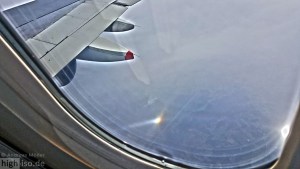Starting in 2015, inscribed members of AKM’s forum were invited to post photographically documented circumhorizon arcs (CHAs). The reach of this mostly German language website and the geographical limit for CHAs at ca. 55° N, restricted the incoming reports to Germany and its surroundings to latitudes between about 47° N and 52° N, in practice. The possible maximum solar elevation angle for these places varies between 61° and 67°, thus not quite attaining the brightness optimum for CHAs, which comes at a little less than 68°. [1]
On the other hand, it has been found that some of the aesthetically more pleasing CHA apparitions occur at 65° solar elevation or less. This is because the CHA gets wider then, therefore increasing the dispersion of spectral colors. Such CHAs are also situated less high in the sky, where they are more easily seen unintentionally. Also then, an interesting landscape in the foreground may add to the scene’s beauty.
The following table contains a summary for the 2015 and 2016 CHA observations. Observations on the same day have been included, if from different places and reported in the said forum or – in just two cases – directly communicated to this author. Chance findings of related CHAs in other public networks and oral reports solicited by an AKM posts are carried separately. For consistency, three CHAs seen in far-away places by a travelling AKM member were not included in the count. The last column contains the count of AKM’s systematic visual observers.

It is clear, that the CHA campaigns for 2015 and 2016 were comparably successful, definitely surpassing the counts for any earlier year. The competitive character of a call for CHAs stipulated an increased time log from skilled observers and made them aware of quite inconspicuous CHAs. Although the meteoros.de forum boasts many hundreds of members, the number of those contributing CHAs, was quite low. The CHA reports for 2015 and 2016, respectively, were delivered by 15 and 19 observers, respectively, who lump together to just 26 different persons for both years. So every CHA reporter on the average had 2.3 specimens. Besides different personal noon-day observing options, the more southerly observers were favored, of course. The most successful six of them recorded 34 CHAs (58% of the grand total).
In concluding, some circumhorizon arc images from 2016 are duplicated from our forum. First place goes to a very nice spectrally pure example, seen June 15th at a solar elevation of 64.1o by Daniel Eggert near Neuburg (Danube).

Photo: Daniel Eggert

Photo: Daniel Eggert
The photo by Isabelle Klein (a) shows a CHA underneath a 22o circumscribed halo, as photographed from the Autobahn A1 near Hermeskeil nine days earlier, on June 6th, at a solar elevation of 63.4o. Unsharp masking of this shot shows an infralateral arc curving upwards from the CHA. Not shown here is the also present complete parhelic circle.
By contrast, Michael Großmann’s photo (b) from Aulendorf, taken June 18th at a solar elevation of 65.3o does not show any hints of a 22o halo.
On July 6th, Elmar Schmidt experienced a long-lasting CHA display in Heidelberg (c). The sky was uniformly covered with cirrus clouds, which washed out the contrast for the halo, which extends for more than 60o of azimuth. To show this better, two portrait oriented wide-angle photos, taken at solar elevation of 63.4o, were stitched together, therefore artificially broadening the circumscribed 22o halo disproportionately w.r. to the CHA.
Karl Kaiser in Schlägl, Austria, took his photo (d) of a delicately colored CHA on July 8th at a solar elevation angle of 63.4o.
-

-
(a) Photo: Isabell Klein
-

-
(b) Photo: Michael Großmann
-

-
(c) Photo: Elmar Schmidt
-

-
(d) Photo: Karl Kaiser
[1] E. Schmidt, A. Haußmann, C. Hinz, P. Zenko: Der Zirkumhorizontalbogen – Teil I: Auftreten und Häufigkeit, VdS-Journal, Nr. 53 (2015), S. 70
Author: Dr. Elmar Schmidt, Bad Schönborn, Germany
 This night conditions were overcast and we were watching halos in spotlight beam. But there was a moment when clouds all turned into ice crystals, allowing moon shine bright and make a passable display. We switched off the spotlight and managed to take some photos before it got cloudy again. Camera lenses were frosted, which caused some blurred areas and bright dots in the images.
This night conditions were overcast and we were watching halos in spotlight beam. But there was a moment when clouds all turned into ice crystals, allowing moon shine bright and make a passable display. We switched off the spotlight and managed to take some photos before it got cloudy again. Camera lenses were frosted, which caused some blurred areas and bright dots in the images.





 (20:03 CET, unsharp masked, for the original image see
(20:03 CET, unsharp masked, for the original image see 
















